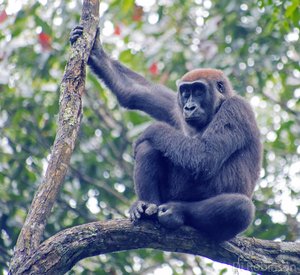Advertisement
Published: July 10th 2016


Calliope, one of the wise female gorillas in the Neptune pack. Photo: Di RobinsonI stared, they stared back. The sun was slowly rising behind a thick blanket of white-grey cloud so the light was dusky but I could clearly see their golden brown eyes looking intently into mine. I breathed hard through my mask, sucking in cloth, exhaling fascination. I was in marantaceae rainforest in the middle of a group of western lowland gorillas, in seventh heaven.
See footage of western lowland gorillas.
The young gorilla I was eyeballing was sitting on a branch practically above my head. One of their friends came bounding down behind them, a bundle of brownish-grey fur and fun, and pushed into them, wanting to play. The two juveniles went hand over hand down tree limbs or swung on vines. A branch broke and they plummeted to the ground but were apparently unhurt.
We had set off at 6 a.m. from Ngaga Camp. We had arrived there the day before after a 40-minute journey in a private plane from Brazzaville. The flight had taken us over endless swathes of savannah and jungle with a winding brown river running through them and deposited us on a strip in the middle of nowhere, where we had


Frogs on the trail. Photo: Di Robinsonbeen picked up by jolly guides and transported to our destination. We arrived at camp in the pouring rain and had drinks on a comfortable verandah, peering through the mist at the trees, lulled after a good dinner to sleep by frog calls and cicadas.
This morning, Matt and I and Andrea, our Swiss companion on this adventure, had set off with our guide and gorilla tracker, Zaafran, to find the Neptune pack. There were two gorilla packs, Neptune and Jupiter (we saw the Jupiter pack the next day). Both had been 'semi-habituated' by Spanish primatologist, Dr Bermejo. 'Semi-habituated' means the gorillas can tolerate people being within a certain distance of them but are still completely wild animals.
Dr Bermejo had worked with these gorillas to undertake research as western lowland gorillas are secretive and can easily disappear in their vast rainforest habitat so not as much is known about them as their relatives, the mountain gorilla. It was also hoped tourists in the Republic of Congo's fledgling tourist industry would interact with them and spread awareness of their plight. Western lowland gorillas are
critically endangered in the IUCN Red List as ebola can wipe out an entire local population, and they are also


White-crested hornbill Tropicranus albocristatus. Photo: Matt Feierabendthreatened by habitat loss through logging, and poaching.
Tracking was fun at first and then wearying. We began by walking down cleared tracks, seeing hornbills, butterflies and lichens. Then the tracker got his machete out and we hacked through the dense marantaceae, a broad-leaved plant with rubbery green leaves on which spiders and beetles rest. It's a benign ecosystem without dangerous insects save the usual malarial mosquito (but there weren't many of them) and it was exciting pretending to be David Attenborough penetrating new hitherto unexplored territory. Then it got tedious and tiring tripping over roots, getting sideswiped by wet leaves. We passed half-eaten pieces of orange fruit strewn on the ground. I picked one up.
'Is that the gorillas?' I asked our guide.
'No, it's a piece of fruit,' he replied, deadpan.
Everyone's a comedian.
Then we passed some trampled down vegetation where the gorillas had slept and a few piles of strong-smelling dung. Excitement rose again.
Come tracking with us.
And here we were, standing thigh deep in thick undergrowth, watching gorillas in the trees eating vegetation, nursing their incredibly cute babies, resting and playing. No sooner had we


Moth on marantaceae. Photo: Di Robinsonarrived than the large silverback, Neptune himself, had descended the trunk of a large tree, powerful muscles ripppling as he climbed down, hand by hand, massive foot by massive foot, and disappeared into the broad-leafed, dense thicket of marantaceae.
We stayed for an hour, wearing masks so we did not pass on any germs to these vulnerable and beautiful animals. And when we left, we could not stop smiling.
Meet the Neptune and Jupiter packs.
Find out more about western lowland gorillas. Read my hub page.
Advertisement
Tot: 0.16s; Tpl: 0.011s; cc: 15; qc: 58; dbt: 0.1056s; 1; m:domysql w:travelblog (10.17.0.13); sld: 1;
; mem: 1.2mb
bren
non-member comment
lovely storytelling
hey di and matt, i enjoyed your post. nice storytelling using different media. the videos are an ideal length. wonderful photos, you are two very lucky people! x B